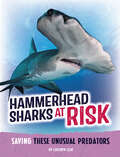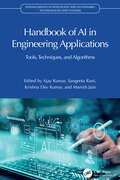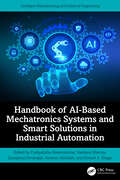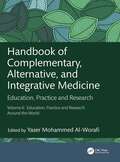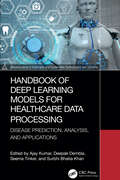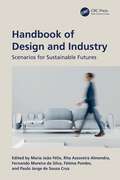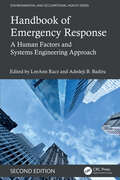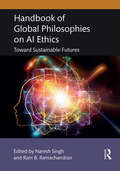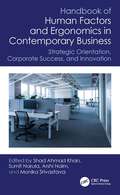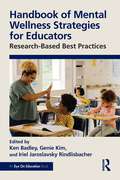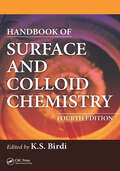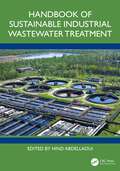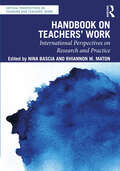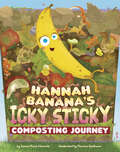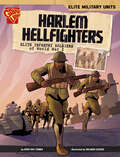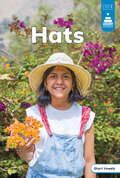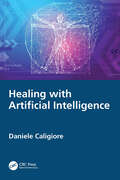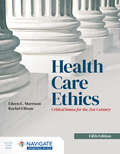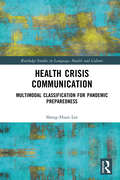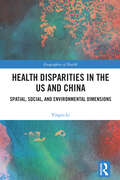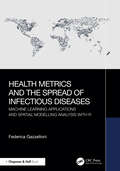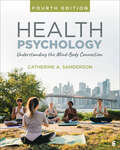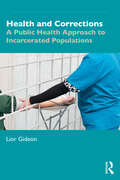- Table View
- List View
Hajj
by Golriz GolkarHajj is a holy journey that every adult Muslim tries to make at least once. Readers can follow the millions of Muslims who gather each summer in Saudi Arabia to visit the Holy Mosque and the Kaaba shrine. Pilgrims pray, fast, and celebrate Eid al-Adha together. Lively photos and easy-to-read text help readers learn about contemporary celebrations of this ancient pilgrimage. Discover how the shared journey of Hajj brings Muslim people together in solemn promises and joyful celebration.
Hammerhead Sharks at Risk
by Kathryn ClayHammerhead sharks have skills and body parts that keep them safe from predators, from their hunting abilities to their sharp teeth. But these unusual sharks are endangered. Because of overfishing and climate change, more hammerheads are dying than are being born. Readers will learn why hammerhead sharks are at risk, what it means to be endangered, and how people can help. Each title includes activities and trivia questions to help readers connect with the content.
Handbook of AI in Engineering Applications: Tools, Techniques, and Algorithms (Advancements in Intelligent and Sustainable Technologies and Systems)
by Ajay Kumar, Sangeeta Rani, Krishna Dev Kumar, and Manish JainThere is a need to categorize artificial intelligence (AI) applications, tools, techniques, and algorithms based on their intended use in various design stages. Specifically, there is a need to explore AI techniques that are utilized for tasks such as designing, including but not limited to inspiration, idea and concept generation, concept evaluation, optimization, decision-making, and modeling. This includes things like generating ideas and concepts, evaluating those ideas, optimizing designs, making decisions, and creating models. This handbook brings all of these categories with compatible AI techniques, tools, and algorithms together in one place.Handbook of AI in Engineering Applications: Tools, Techniques, and Algorithms covers applications of AI in engineering and highlights areas such as future cities, mechanical system analysis, and robotic process automation, and presents the application of AI and the use of computerized systems that aim to simplify and automate the processes of design and construction of civil works. The handbook discusses the design and optimization of mechanical systems and parts, such as engines, gears, and bearings, which can be automated using AI and it explores the performance of robotics and automation systems which can be simulated and analyzed using AI to forecast behavior, spot future issues, and suggest changes. Rounding out this handbook is AI technology automation and how analyzing relevant data can provide a reliable basis for relevant personnel to carry out their work.This handbook fills the gap between R&D in AI and will benefit all stakeholders including industries, professionals, technologists, academics, research scholars, senior graduate students, government, and public healthcare professionals.
Handbook of AI-Based Mechatronics Systems and Smart Solutions in Industrial Automation (Intelligent Manufacturing and Industrial Engineering)
by Vandana Sharma Pushpalatha Naveenkumar Gunapriya DevarajanArtificial intelligence (AI) and mechatronics are booming areas where most of the industrial sectors are becoming smart nowadays. This handbook includes material of multidisciplinary content from the AI, mechanical, and electronics engineering domains, among others. It gives insights into various application sectors discussing current global developments in mechatronics employing AI technology and addressing the complexity of current issues and the effects of diverse mechatronics systems.Handbook of AI-Based Mechatronics Systems and Smart Solutions in Industrial Automation focuses on system automation, predictive analysis, preventive analysis, and real-time decision-making systems for next-generation automation. It discusses the advancements of mechatronics systems using AI applications along with the global approach toward smart industrial automation and presents the impact of AI on today’s work of autonomous and industrial automation. The book discusses future research potential and is beneficial to manufacturing, healthcare, and finance disputes, while it offers AI algorithms to analyze large amounts of data and identifies patterns, trends, and anomalies for accurate predictions and optimization processes. The handbook also addresses use cases and case studies related to AI in mechatronics along with applications.Scholars in the field of AI in mechatronics and related applications will find this book useful. In particular, attention is drawn to both fundamental ideas and important practical contexts. Readers interested in the most recent findings in the field of problem-oriented processing approaches in mechatronics, including those in academia, data science, industry, research, and graduate and undergraduate students, will find this fascinating handbook extremely interesting.
Handbook of Complementary, Alternative, and Integrative Medicine: Education, Practice and Research, Vol.6: Education, Practice and Research Around the World
by Al-Worafi, Yaser MohammedPresenting information on more than 30 countries, this book addresses Complementary, Alternative, and Integrative Medicine (CAM) education, practice, and research issues, and regulations and laws, prevalence, and workforce issues, among other topics. It is Volume 6 of six that describe the education, practice and research-related issues and the efficacy and safety of CAM in treating various conditions. The purpose of these six volumes (sold individually or as a set) is to explain how complementary, alternative, and integrative medicine is practiced around the world, to share the best practices/experiences in terms of education, practice, and research, and identify the challenges and suggest recommendations to overcome the identified challenges.Key Features• Describes the complementary, alternative, and integrative medicine education, practice, and research in more than 30 countries• Aims to share information and establish best practices in complementary, alternative, and integrative medicine research• Country by country, it presents regulations and laws, prevalence, and workforce issues in CAM
Handbook of Deep Learning Models for Healthcare Data Processing: Disease Prediction, Analysis, and Applications (Advancements in Intelligent and Sustainable Technologies and Systems)
by Ajay Kumar Surbhi Bhatia Khan Deepak Dembla Seema TinkerIn recent years, deep learning has shown great potential in transforming various fields including healthcare. With the abundance of healthcare data being generated every day, there is a pressing need to develop efficient algorithms that can process and analyze this data to improve patient care and treatment outcomes.Handbook of Deep Learning Models for Healthcare Data Processing: Disease Prediction, Analysis, and Applications covers a wide range of deep learning models, techniques, and applications in healthcare data processing, analysis, and disease prediction, providing a comprehensive overview of the field. It focuses on the practical application of deep learning models in healthcare and offers step-by-step instructions for building and deploying models and using real-world examples. The handbook discusses the potential future applications of deep learning models in healthcare, such as precision medicine, personalized treatment, and clinical decision support. It also addresses the ethical considerations associated with the use of deep learning models in healthcare, such as privacy, security, and bias. It provides technical details on deep learning models, including their architecture, training methods, and optimization techniques, making it useful for data scientists and researchers.Written to be a comprehensive guide for healthcare professionals, researchers, and data analysts, this handbook is an essential need for those who are interested in using deep learning models to analyze and process healthcare data. It is also suitable for those who have a basic understanding of machine learning and want to learn more about the latest advancements in deep learning in healthcare.
Handbook of Design and Industry: Scenarios for Sustainable Futures
by Rita Assoreira Almendra Maria João Félix Fátima Pombo Moreira da Silva, Fernando Jorge de Sousa Cruz, PauloThe twenty-first century has been beset by a global pandemic, war and increasingly concerning environmental disasters. Designers and industries have been forced to imagine a world in which the only way to move forward is to look back. The design and industry sectors need to understand the role they can play in removing obstacles to social progress and work together to create healthier human societies that can interact with the world in a sustainable way.This book presents contributions from leading experts that reveal that a better and more prosperous world is achievable through good work and system design. This book consists of chapters that bring together researchers, academics, policy makers, and designers from technology companies and business associations with the objective of developing a focused vision that enhances innovation through design and industry for a better future. Through a transdisciplinary scientific exchange, it lists responses to the challenges of climate change and environmental degradation that will contribute to a more modern, resource-efficient, competitive economy, with smart, sustainable, and inclusive growth, promoting knowledge, inter-sector collaboration, health, education and a digital society for all. By putting the human at the heart of what can be accomplished, this book investigates better design in the disciplines of work, healthcare, product, system, manufacturing, and industry. The reader will gather an interdisciplinary perspective on what good design can achieve and why it is needed to challenge the climate crisis.The Handbook of Design and Industry: Scenarios for Sustainable Futures is essential reading for researchers and academics in the fields and disciplines of ergonomics/human factors, occupational health and safety, industrial design, product design, industrial engineering, materials engineering, process engineering, computer engineering, communication design, electronics and telecommunications engineering.
Handbook of Emergency Response: A Human Factors and Systems Engineering Approach, Second Edition (Environmental and Occupational Health Series)
by LeeAnn Racz and Adedeji B. BadiruDespite pre-emptive preparations, disasters can and do occur and are a fact of life. Whether natural disasters, catastrophic accidents, or terrorist attacks, the risk cannot be completely eliminated. A carefully prepared response is your best defense. This fully updated second edition of the Handbook of Emergency Response presents practical advice and guidelines on how to plan the coordinated execution of emergency response.This handbook incorporates human factors and a systems engineering approach to emergency response project management. It provides cutting-edge research in developing a systematic structure for communication, cooperation, and coordination. Managing a project in the wake of a tragedy is complicated and involves various emotional, sentimental, reactive, and chaotic responses. This is the time when a structured communication model is most needed. This second edition includes important lessons learned and developments since the first edition was published, as well as additional information devoted to systems thinking and industrial engineering in planning for responses to emergencies. The reader will develop a thorough understanding of how to handle an emergency response using a systems approach.The handbook is an ideal purchase for any student or practitioner of human factors, safety, systems engineering, events management, local or federal governance, or those in the emergency services.
Handbook of Global Philosophies on AI Ethics: Toward Sustainable Futures
by Naresh Singh Ram B. RamachandranThis book offers an exploration of the diverse perspectives shaping the future of artificial intelligence (AI), highlighting the influence of non-Western thinking in its development. What would the impact be if AI were developed with the wisdom of Ubuntu, the harmony of Confucian thought, or the Indian principle of Vasudhaiva Kutumbakam, "the world is one family", at its core? This thought-provoking collection brings together leading voices from around the globe to reimagine AI systems that are fair, ethical, and inclusive. Addressing critical issues such as bias, fairness, privacy, and existential risks, it challenges the status quo and envisions a future where AI reflects the values of all humanity—not just a select few. Exploring the influence of topics like religion, culture, and social movements, the book examines how these perspectives shape AI’s application in industries such as finance, education, and the military, while underscoring the importance of establishing robust ethical guardrails. Whether you’re a curious reader, a policy maker, a scholar, or a tech innovator, this book is your guide to understanding how different cultural perspectives can redefine AI ethics. It’s time to ask: what kind of world do we want AI to build for us all?
Handbook of Human Factors and Ergonomics in Contemporary Business: Strategic Orientation, Corporate Success and Innovation
by Monika Srivastava Arshi Naim Shad Ahmad Khan Sumit NarulaHandbook of Human Factors and Ergonomics in Contemporary Business highlights the symbiotic relationship between human-centric approaches and organizational success in 21st century business and corporate culture. It delivers a comprehensive exploration of how integrating human factors and ergonomics strategically can fuel innovation, enhance performance, and deliver a competitive advantage.By promoting employee wellbeing to implementing ergonomic interventions for heightened productivity, the chapters offer invaluable insights into the role of human factors across differing business sectors. Edited and authored by distinguished experts in the field, this handbook presents theoretical frameworks, empirical evidence, and real-world case studies. Across these chapters split into various sections on perspectives, digitalization and wellbeing, it provides interdisciplinary perspectives and practical applications to equip readers with the tools needed to encourage thriving workplace environments, nurture employee welfare, and foster innovation and creativity. International case studies from diverse businesses and topics on Industry 5.0, logistics, strategy, UX, productivity, green issues and much more result in a thorough overview of the topic. It will help any reader optimize organizational performance and understand the key connections between human factors and business success.This title is an essential read for researchers and professionals in ergonomics and human factors, business and management, leadership, engineering design and human resources.
Handbook of Mental Wellness Strategies for Educators: Research-Based Best Practices
by Ken Badley Genie Kim Iriel Jaroslavsky RindlisbacherThe Handbook of Mental Wellness Strategies for Educators offers health-giving ways to reframe teaching work and the stresses that come with it, examining specific evidence-based strategies for dealing with teaching anxieties and trauma-related stressors. This comprehensive and scholarly volume, which intentionally steers clear of burnout literature, pinpoints several sources of teacher anxiety and suggests specific linguistic and cognitive strategies to support educators in finding positive, solution-oriented ways to navigate issues they inevitably face. Throughout the volume, chapter authors emphasize the role of teaching dispositions and describe some of the day-to-day classroom practices used by veteran colleagues to reduce stress and anxiety on the job. This handbook is essential reading for pre-service and in-service teachers, scholars, and teacher educators.
Handbook of Surface and Colloid Chemistry
by K. S. BirdiThis new edition of the Handbook of Surface and Colloid Chemistry informs you of significant recent developments in the field. It highlights new applications and provides revised insight on surface and colloid chemistry's growing role in industrial innovations. The contributors to each chapter are internationally recognized experts. Several chapter
Handbook of Sustainable Industrial Wastewater Treatment
by Hind AbdellaouiThe Handbook of Sustainable Industrial Wastewater Treatment is an indispensable resource for addressing the pressing challenges of wastewater management through innovative and sustainable technologies. This comprehensive guide delves into the intricacies of pollutant classification, the impacts of climate change, and a variety of effective treatment methods, making it a must-have for professionals in the field.This handbook equips readers with the essential knowledge to maintain efficient water treatment systems while implementing sustainable practices that prioritize environmental protection. It showcases cutting-edge treatment technologies capable of removing over 99% of contaminants, all while minimizing maintenance needs, energy consumption, and chemical usage. By offering eco-friendly solutions that significantly reduce operational costs, this handbook emerges as a vital tool for enhancing wastewater management practices across industries.In addition to traditional methods, this handbook explores innovative strategies that not only improve water quality but also promote resource conservation, ultimately supporting broader environmental sustainability goals. Tailored specifically for researchers, academicians, and professionals in hydrology, environmental science, agricultural engineering, and water resource management, this handbook also benefits postgraduate and doctoral students engaged in water-related research.
Handbook on Teachers’ Work: International Perspectives on Research and Practice (Critical Perspectives on Teaching and Teachers’ Work)
by Nina BasciaThe Handbook on Teachers’ Work brings together research and evidence-based authoritative writings from across the globe that explicitly theorizes and studies teachers’ work.Drawing on research from twelve countries across 6 continents, the chapters are grouped into themes that represent key issues related to work from global perspectives, including: The Political and Policy Contexts of Teachers' Work Teaching as an Occupation Diverse Teacher Identities and Roles Teaching as Collective and Relational Work; and Teaching and Activism The volume explores the idea of teaching as an occupation with a history and trajectory that are shaped by political economies; historical progressions; organizational structures; social relations among educators, students, and others; teachers’ career and labor patterns; their professional norms; and raced, gendered, classed, and culturally linked expectations of teachers and about public schooling.This essential handbook will be of interest to teacher educators, policymakers, and students and researchers in the fields of teachers’ work, curriculum theory, educational policy and politics, foundations of education, multicultural education and teacher education.
Hannah Banana's Icky, Sticky Composting Journey
by Jamee-Marie EdwardsFollow along as Hannah Banana goes from the fruit bowl to the compost bucket to the compost pile and beyond. Engaging and packed with facts, this book takes readers on a step-by-step illustrated adventure to uncover the icky, sticky journey of composting.
Harlem Hellfighters
by Myra Faye TurnerIn this action-packed graphic novel, readers explore the true story of the Harlem Hellfighters, one of the most courageous and decorated all-Black military units of World War I. Despite facing discrimination in the United States and across the globe, the Harlem Hellfighters earned a reputation as fierce fighters on the battlefield. Follow their journey from New York to the front lines in France during WWI, where they proved their valor and changed the way the world viewed Black soldiers. With fast-paced storytelling and vivid illustrations, this gripping graphic novel honors the bravery of the individuals who stood up against racism and fought for their country.
Hats
by Laura StickneyAll around the world, hats come in all shapes and sizes! Beginning readers hone their phonics skills while learning about many different types of hats, from ball caps to top hats. As readers practice decoding words with short vowel sounds, they gain nonfiction knowledge. Every Stairway Decodables book combines multiple aspects of the Science of Reading to support small group instruction, independent reading, and reading practice at home.
Healing with Artificial Intelligence
by Daniele CaligioreDiagnosis through images, robot surgeons, digital twins, and the metaverse are some of the applications in which artificial intelligence (AI) is involved. It is an almost sci-fi world that touches us closely and toward which we can harbor both great hopes and great fears. Health, in fact, is a central theme, and understanding how this new technology can help us to heal, acquire well-being, and live better is certainly important. This book, thanks to the author’s great experience, deals comprehensively and accessibly with the benefits and risks of using AI in the field of health. It will enable the reader to confidently approach a revolution that will change the way we treat ourselves.
Health Care Ethics
by Eileen E. Morrison Rachel EllisonFocused on today’s critical issues from an ethical standpoint, Health Care Ethics: Critical Issues for the 21st Century, Fifth Edition brings together the insights of a diverse panel of leading experts in the fields of bioethics, long-term care, and health administration, and more, to examine the key issues for individuals, organizations, and society. The early chapters of this thought-provoking book offer readers a solid understanding of healthcare ethics. They cover the fundamental principles and theories that underpin healthcare ethics. Later chapters shift the focus to the pressing issues of our time, such as autonomy, the patient's right to choose, health inequities, health inequality, COVID-19, and ethical decision-making. These chapters also introduce the ethical theories, their application, and the principles that guide them.
Health Crisis Communication: Multimodal Classification for Pandemic Preparedness (Routledge Studies in Language, Health and Culture)
by Sheng-Hsun LeeSheng-Hsun Lee develops a new way of understanding public health crisis communication through the lens of multimodal classification. He draws on examples from COVID-19 press conferences in Taiwan and public online comments to outline multimodal classification as sorting pandemic phenomena into categorical types.Lee argues that when public health officials classify health crisis phenomena into categories, they also set parameters for official responses and shape public perceptions of a crisis. He illustrates the argument through examining Taiwan’s initial successes in keeping most infections at bay and subsequent challenges of obtaining enough vaccines for international border reopening. The successes and challenges are closely linked to multimodal classification, which includes using speech, gestures, and objects to make some categories travel broadly and impede the circulation of other categories. The book discusses a wide range of crisis categories from the three dreadful first times—the first confirmed case, the first community-acquired case, and the first death—to the politicized debate over vaccine brands. Lee emphasizes the importance of understanding how crisis categories are produced, circulated, and received. The comprehensive coverage looks beyond initial responses to the COVID-19 pandemic and outside English-dominant places to redefine effective public health messaging. Based on the findings, the book highlights implications for communicating official messages and offers a list of ready-to-use strategies for updating existing guidelines on public health communication.The book is an essential read for public health practitioners and researchers and advanced students in discourse analysis and public health communication.
Health Disparities in the US and China: Spatial, Social, and Environmental Dimensions (Geographies of Health Series)
by Yingru LiThis book provides a comprehensive insight into health disparities in both the United States and China. It offers valuable perspectives on public health and policy through an examination of the spatial, social, and environmental dimensions of health disparities.Through comparative analysis of two distinct healthcare systems, economic conditions, and cultural contexts, the book offers a thorough assessment of how policies and social structures influence public health outcomes. It examines factors such as socioeconomic status, social capital, community, social and physical environments, healthcare systems, and health policies. The book adopts an interdisciplinary approach, drawing on key theoretical frameworks such as socio-ecological model, social determinants of health (SDOH), and social capital theory. It integrates geospatial, statistical, and survey analyses and includes a series of case studies to explore health disparities.This book will be of interest to students and researchers in medical geography, medical sociology, and public health, as well as professionals and policy makers who address spatial, social, and environmental disparities.
Health Metrics and the Spread of Infectious Diseases: Machine Learning Applications and Spatial Modelling Analysis with R
by Federica GazzelloniHealth Metrics and the Spread of Infectious Diseases: Machine Learning Applications and Spatial Modelling Analysis with R is an introductory guide to health metrics and infectious diseases. It demonstrates how to calculate these metrics to compare the health status of different countries and explores the world of infectious diseases. It tests various machine learning tools for analyzing trends and relationships among key variables, aiming to prevent unexpected outcomes. Through detailed explanations and practical examples, readers will gain a comprehensive understanding of Disability Adjusted Life Years (DALYs) and their components.Key Features: Structured into four main sections—foundational health metrics, machine learning applications, data visualization, and real-world case studies Integrates real-world case studies with data visualization and machine learning techniques, including spatial modelling with the R programming language Covers specific infectious diseases such as COVID-19 and malaria, providing insights into their spread and control Includes detailed explanations, practical exercises, and clear illustrations to enhance understanding and application Adopts a practical approach, making advanced concepts accessible to a wide audience The book is primarily aimed at researchers, data scientists, and public health professionals who seek to leverage data to improve health outcomes. By blending theoretical knowledge with practical applications, the book equips readers with the tools to make informed decisions and produce meaningful data analyses in public health.
Health Psychology: Understanding the Mind-Body Connection
by Catherine A. SandersonHealth Psychology: Understanding the Mind-Body Connection by Catherine A. Sanderson provides an exceptionally clear overview of the field by connecting foundational concepts with cutting-edge research and real-life applications. Now available with the Vantage learning platform, every chapter is thoroughly updated with 30+ new references to reflect changes since the COVID-19 pandemic with a special emphasis on social determinants of health. Recent studies look at topics such as the role of TikTok and other social media platforms in shaping health-related behavior, the influence of anti-transgender laws on suicide attempts, the role of neighborhood green space in preventing chronic illness, and the impact of having good relationships on longevity. Continuing her emphasis on the importance of research methods, the author has updated every Research in Action feature, addressing questions such as Do celebrities help or harm health-related behavior? and Are presidential elections bad for your heart? Finally, the feature Applying Health Psychology to Your Own Life invites students to try highly relevant research-supported strategies for themselves.
Health Psychology: Understanding the Mind-Body Connection
by Catherine A. SandersonHealth Psychology: Understanding the Mind-Body Connection provides an exceptionally clear overview of the field by connecting foundational concepts with cutting-edge research and real-life applications. Recent studies look at topics such as the role of TikTok and other social media platforms in shaping health-related behavior, the role of neighborhood green space in preventing chronic illness, and the impact of having good relationships on longevity. Continuing the emphasis on the importance of research methods, author Catherine A. Sanderson has updated every Research in Action feature, addressing questions such as Do celebrities help or harm health-related behavior? and Are presidential elections bad for your heart? Each chapter in the new Fourth Edition has been thoroughly updated with 30+ new references to reflect changes since the COVID-19 pandemic, with a special emphasis on social determinants of health. This text is offered in Sage Vantage, an intuitive learning platform that integrates quality Sage textbook content with assignable multimedia activities and auto-graded assessments to drive student engagement and ensure accountability. Unparalleled in its ease of use and built for dynamic teaching and learning, Vantage offers customizable LMS integration and best-in-class support. Instructors, see how Vantage works! Take a brief self-guided tour with our interactive demo
Health and Corrections: A Public Health Approach to Incarcerated Populations
by Lior GideonPutting forward a new approach to the study of corrections, this book draws together public health and corrections and explores the importance of this nexus.Presenting a theoretical overview of relevant sociological and public health theories, the book introduces basic concepts, terminology, analytical frameworks, and theories, covering major issues in the domain of public health, public safety, and criminal justice. Addressing incarcerated population health needs in correctional setting, it provides an accessible and panoramic overview of the policy impact of laws on the health of incarcerated individuals. In doing so, the book investigates a variety of topics, including preincarceration and prison-generated trauma, chronic health issues, contagious infectious diseases, and aging in the system. The focus is on four “special-needs populations”: (1) women’s health; (2) mental illness among inmates; (3) elderly and geriatric inmates; and (4) substance abusing inmates. Giving an organizational perspective to the topic of health and corrections, the book also considers violence, public health in the community, access to health services by marginalized individuals, and why it matters to discuss health in prisons, the living conditions in prison, health management, and the health and well-being of those engaged with incarcerated individuals.Health and Corrections aims to generate an important discussion on the nexus of health and justice and will be a valuable resource for students, researchers, and instructors, as well as for professionals in the field of corrections, criminal justice, and public health and safety.

